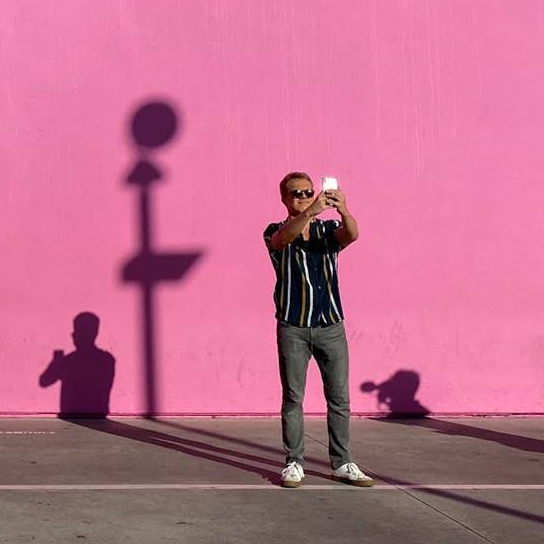The Pink Wall at Melrose and Harper Avenues in Los Angeles is a tourist destination like no other. On any given day, thousands of hipsters and self-described echo boomers flock to the wall, which is home to the retailer Paul Smith and looks like it’s been doused with 10,000 bottles of Pepto Bismol, to snap an Instagram photo. The wall is so popular, in fact, that it’s become one of L.A.’s top tourist destinations.
In early 2019, when I started filming Fake Famous, a social experiment and documentary about influencer culture and the fictitious and spurious world of online fame, it seemed only right that a bright-pink wall turned top tourist destination should be the first location viewers see. (Full disclosure: AIR MAIL’s co-editor Graydon Carter is one of the movie’s producers.) So we set up high-end slow-motion cameras at the wall and filmed tourists posing with selfie sticks as if they were being shot for the cover of Vogue. The film opens with this spectacle, accompanied by dazzling opera music scored by Michael Abels (Get Out).

The reason people flock to this wall is simple: as hundreds of millions of people spend billions of hours a day thumbing through a never-ending stream of images on their phones, photos shot against a pink background stand out, get a little double tap, and maybe, if you’re lucky, maybe an emoji comment. If you’re really, really lucky, you might even get a couple of followers.
Another Day, Another Follower
Followers, likes, and comments are the currency that makes people “famous” today, or at least appear that way. But in reality, as we show in Fake Famous, it’s almost all bullshit. In the film, we took three random people with a miniscule following online and made them appear famous by simply buying them fake followers (also know as “bots”) and then showering them with fake likes and comments on their feeds, all with the goal of seeing how their lives changed as a result of this “fame.”

I had assumed that this experiment would be pretty straightforward, but it was far from that. Fake followers started showing up in droves. One of our fake influencers spun into a full-fledged panic after someone noticed he was buying fake bots. (It was actually I who was buying them.) Another of our subjects decided not to be part of the experiment anymore and started to delete all my fake comments. And the third subject was so successful at being perceived as an influencer that we grew terrified we’d be sued for accepting a free vacation from the MGM Grand in Las Vegas—which, perhaps luckily, we had to cancel because of the pandemic.
Then there were the bots, which soon started to take over my own life. It’s imperative as a fake influencer that your fake likes and fake comments show up on time, or someone could easily tell your fake life is, well, fake. To ensure this didn’t happen to our three subjects, I found myself buying bots while driving, at breakfast, in bed at three A.M.—even while changing my son’s diaper. I had to go deep into the underbelly of the Internet to find the best bot dealers (who are sometimes in their teens, and often located in far-off locations, such as Egypt and Ukraine) and ones who wouldn’t rip me off. I discovered that some bot dealers will charge anywhere from $50 to $500, and then the bots never arrive. There was little I could do about this, obviously. Am I going to call the cops and say some fake bots I’d bought for a documentary never showed up from a 14-year-old kid in Egypt?

I realized pretty quickly that the narrative structure we had decided on initially—a social experiment that easily could have imploded—was probably not the most astute choice for a first-time director. It felt like, at every turn, the whole thing could unravel and the film fall apart. Not only did we have to manage three very distinct personalities, and manage the hundreds of thousands of bots that were following them (and the bot dealers ripping me off), there was also the potential of legal threats from businesses giving our “influencers” free stuff.
We took three random people and made them appear famous by simply buying them fake followers and then showering them with fake likes and comments.
Then there was the pandemic, which hit 21 days into our 27 days of filming. Our original goal for the end of the film was to get one of our fake influencers to a million fake followers, and then have a “One Million Followers Party,” sponsored by dozens of brands at a fancy Los Angeles hotel. When the coronavirus hit, we had to rethink our ending. But looking back now, I can’t imagine a more appropriate final moment for the film.
Fake Famous premieres February 2 on HBO
Nick Bilton is a journalist and the author of several books, including Hatching Twitter: A True Story of Money, Power, Friendship, and Betrayal and, most recently, American Kingpin: The Epic Hunt for the Criminal Mastermind Behind the Silk Road
